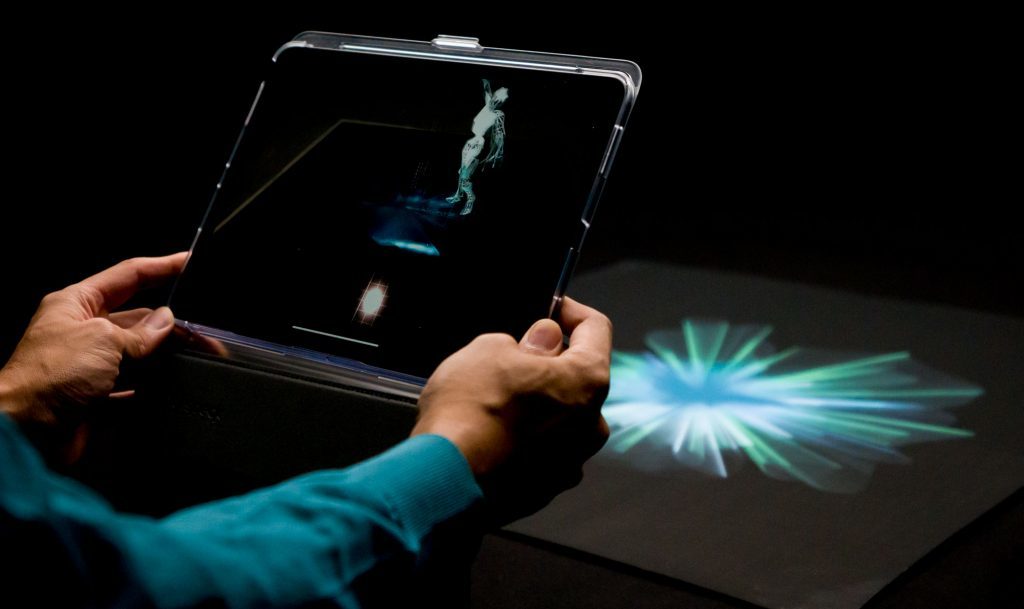By Matthew Koehler

Rushing into ARTECHOUSE, I gave my name to one of the hosts in an exhalation of breath before taking another big gulp of air. They didn’t have me on the list but, “Not to worry,” the cheerful host said, “Are you part of the media?” I smiled and replied in the affirmative. “That’s not a problem,” she assured me, “we can just add you to the list.”
I grabbed my complimentary shoe-socks (required for the exhibit) and followed a small crowd of late arrivals downstairs to Lucid Motion, a new interactive dance-themed exhibit by Japanese designer and dj, Daito Manabe, and his company Rhizomatiks. There, an usher greeted us and explained Motion as an “augmented reality that gives [people] a different perspective [o]n an artform that we all might be familiar with [to] create new kinds of experiences.”
Manabe has some notable past and current collabs with big names, including Bjork and European Organization for Nuclear Research (that’s, CERN), to name a few. His company Rhizomatiks, of which he is now co-director, pushes the boundaries in art and technology and human motion. Lucid Motion is his first solo exhibition in the US.
Stepping into the cavernous main showroom of ARTECHOUSE, electronica hit my eardrums full force and a large 3D figure dancing on the projector screen surrounding half the room commandeered my eyes. Made of pulsing and changing light patterns, the 10′ virtual dancer pirouetted, kicked, and moved her arms in precise and fluid movements. Traceable geometric lines sprouted from her hands and feet, and, despite her virtual nature, she moved like a real person. Her realness wasn’t surprising considering Manabe collaborated with real life Japanese dancer and choreographer, MIKIKO, and futuristic dance troupe Elevenplay.
To the left of the main showroom was a sleek bar serving “augmented reality cocktails”, but no one was there yet so I went down to the main floor to the many arrayed bean bag chairs. One patron was spread-eagled on such a chair, angled so he could observe the entire virtual performance. Perhaps he had the right idea.
Two doors, right and left, lead off to side exhibits. Being a righty, I chose that door and entered a small room with a smaller screen playing completely different visuals than the main room. Watching the screen for a minute, I noticed it reacting to the 3D dancer’s music. There was something else, but I couldn’t quite put my finger on it.
Taking the left door, a short passageway with several blank screens led to an interactive media lab. At first, the screens were dark – static – but pausing in the middle of the passageway to jot down some notes, the screen next to me came to life. A multicolored outline of me appeared, complete with me pulling my notebook out of my back pocket. As I stood there waving my arms, I noticed my silhouette morphing in-tune with the music from the main room – like with exhibit through the door on the right. I walked back and forth through that hallway a few times until another patron caught me dancing.
Then I remembered what struck me about the previous side exhibit I’d visited. That screen had interacted with me in a similar way.
Before entering the sparsely decorated media lab at the end of the passageway, a different usher explained the purpose and use of the room. Several black tables with iPads and mundane objects on them (a lamp, for example, and a control panel that could’ve come off Darth Vader’s cyber suit) made up the perimeter of the exhibit. Black posters adorned the wall in places with a 2D graphic poster on a table in the center. Using the iPads to view each exhibit, 3D objects appeared in the air above or around each object or poster.
Dancers, of course, popped out of thin air and moved like marionettes on the iPads, turning the ordinary into dynamic pieces of art. Think of it like those smartphone apps that can turn walks to the grocery store into game (Pokémon Go or The Walking Dead, for example) but with a little pirouetting dancers.
My final stop was the bar, now serving a growing crowd “Augmented Reality Cocktails”, which didn’t have names, just ingredients. Was this intentional? Likely. According to the usher who greeted us before entering Motion, the drinks were “crafted [in conjunction] with the exhibition in both taste and visuals”. As to the taste of these cocktails, well that’s subjective – as is all art – but the visuals I can attest to. Drinks were served on on a tiny dias (when they could find them, they were in high demand) that made the cocktail glasses light up and change colors. Others were served with seemingly boring coasters or other pieces of paper that came alive while using the ARTECHOUSE app, which you should download beforehand.

While my drink changed colors, I struck up a conversation with Courtney from NW DC, who had a sleeping infant in her arms. She’d heard about the event from a friend and wanted to come check it out. Both of us being parents, though, the conversation quickly veered away from art and culture to schools, parenting, and our origins in DC – all while Manabe’s Lucid Motion played in the background. Courtney’s baby slept soundly, never stirring – perhaps he was dreaming lucid dreams. And dancing.
Lucid Motion is showing at ARTECHOUSE until December 1. Tickets range from $8-$20. For more information, visit https://www.dc.artechouse.com/lucidmotion.

